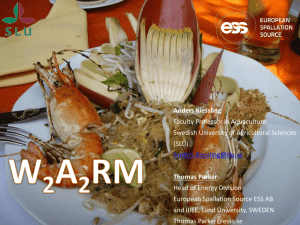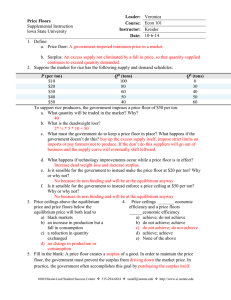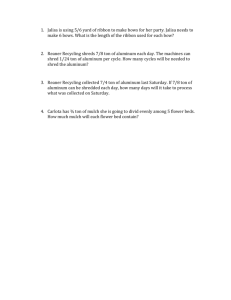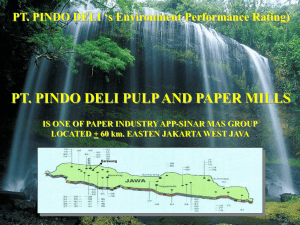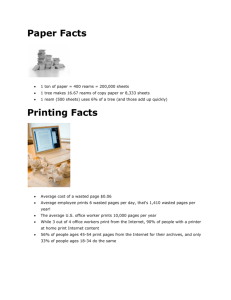Kiessling__Cern_October_2013_ver_3
advertisement
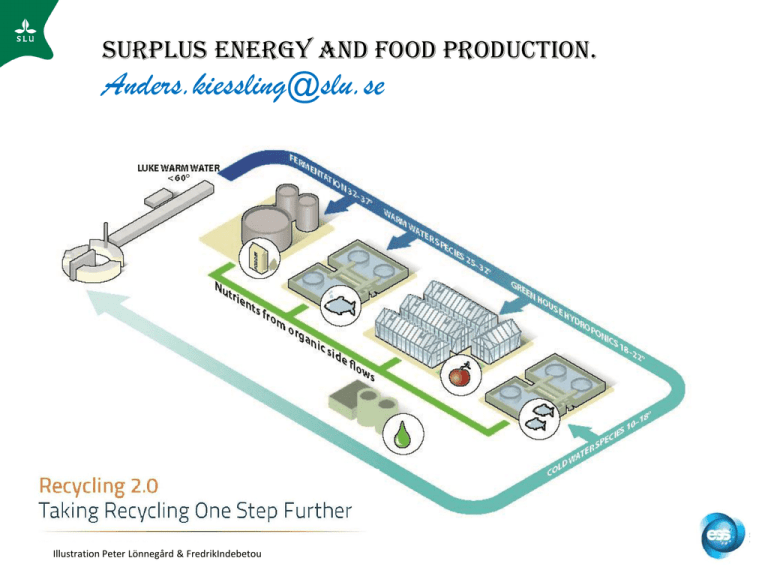
Surplus Energy and food production. Anders.kiessling@slu.se Illustration Peter Lönnegård & FredrikIndebetou Illustration A.Kiessling The linear flow of nutrients, Illustration A.Kiessling which by default will lead to deprivation at one point and accumulation at another Food productivity, on the other hand, Is a direct function of this energy influx in combination with access to fresh water. An increase in temperature from 8.6 to 13.7 oC doubled the growth rate in salmon smolt. T= 5C Weight (average) in grams T= 5C Days Surplus Heat 1. Enormous amounts of heat < 60 oC is lost as cooling, ventilation or insufficient insulation. 2. In Sweden it is estimated to 150 TWh => ¼ of Swedish energy use. 3. In EU it is estimated to 500 billions Euro in petrol equivalents. 4. Growth of fish, plants, algae are all stimulated by a moderate increase in temperature. Example of mass production of low grade surplus heat : Ringhals Nuclear power plant 163 m3 / sec Södra Cell Pulp mill 100.000 m3 / day (1.2 m3 / sec) 10 oC over ambient due to environmental legislation Is there an advantage to produce in water when utilising low grade surplus heat ? 0 0 0 2 5 C 2 5 C 70-80 C 70-80 C 25 C 25 C Production Illustration A.Kiessling Production Cooling chain: From heat to food Luke warm water < 60 oC Low temp drying 40-60 oC Bio generators Microbes yeast Bacteria 32-35 oC Warm water species Tilapia, shrimp and domestic Like perch, pike perch, turbot 22-32 oC Micro Algae CO2 Green house Hydroponics 18-22 oC O2 Cold water species: salmonids, white fish, sturgeon, carp fishes, eel, crayfish etc. 10-18 oC Nutrients from organic side flows: Food waste, bio diesel, bio gas, etc Illustration A.Kiessling Present production systems 47% of soy and 60% of corn produced in the US is used in animal feed. (Grace Communication Foundation) And about ¼ of world catches of fish is used as animal feed. Feed** Food Production Animal (non arable land) based food production system (FAO, 2012) Plant (arable land and irrigation) based food production system *European farmers use about 9 million tons of fertilizer per year Time **European farmers import the equivalent of 50 million tones of soybean per year. Illustration A.Kiessling Fossil based fertilizers* The Problem !! We end up with less food Food Production Animal arable land) based Fluctuating and(non increasing prices food production system And if combined with local weather effects => The OECD/FAO Outlook warns: A wide-spread drought such as the one experienced in 2012, on andraise irrigation) top of lowPlant food(arable stocks,land could worldbased prices food production system by 15-40 percent." Time Illustration A.Kiessling Animal or Man ? Aquaculture Fastest growing food system Has a special role in closing the : “Nutrient loop” Original compost by Ewos, based on Åsgård et al. 1999 Microbes are the base of the food web evolution of all higher animals including ruminants. By Sergio Zimmermann Growth rate / day: Bacteria every 20 min => Yeast every 2 h => Micro algae once a day => 272 212 21 Microbes have high levels of RNA (10-15%) due to high protein synthesis. In mammals uric acid => kidney stones and gout Living cells metabolizing the N in RNA to: RNA relay the information of DNA to the protein synthesis To water Fish => Has all enzymes to eat large amounts of microbes Picture courtesy of Matilda Olstorpe 25-30 oC Green water farming By Sergio Zimmermann Microbial protein / Bio-protein meal Micro fungi Need low temp drying 10% DM in bio-generator 90% DM in protein meal Yeast (otherwise reduced quality) Need 30 mil. ton protein to aquaculture alone 2030 => Dry 48 mil. ton water Bacteria Swedish Yeast company. Produce 20.000 ton yeast/year 1. 10 mg of yeast => 150 ton, in a week. 2. Global protein production by wheat: 1.74 x 103 ton protein => 9.7 x 106 ton protein (low in lysine, arginine and methionine). 3. If use same amount of yeast protein using: (1.74 x 103 ) / 10-5 ) x 150 x 52 = 1.4 x 1012 ton protein (amino acid composition as fish meat) 4. If makes salmon feed of 40% protein (90% DM), with a FC of 1 and a slaughter yield of 60% => 5. Present production and harvest of fish, given as fillet, is roughly 1.2 x 108 ton of fish 6. To dry that amount of yeast (48% protein content) one needs 4.2 x 1015 kwh (1.5 kwh/kg yeast) 7. Present global soy meal production is roughly 113 million ton 3.3 x 1012 ton of salmon 1.3 x 108 ton soy meal (48% protein) 1.3 x 108 ton fish meal (72% protein) 1.3 x 108 ton yeast (48 % protein) => 3.6 x 1011 kwh (mainly fossil) => 5.8 x 1011 kwh (mainly diesel) => 1.9 x 1011 kwh (low temp (surplus) energy) Picture courtesy of Matilda Olstorpe Do we need to care ? Photo courtesy of Aquabest Food is second to drinking water the most central priority to man 1. Global food security is based on wheat, soy, corn, rice. 2. We loose arable land due to present farming practices and human activities. 3. We treat our fresh water as waste baskets and in the same time is many rivers dry even before reaching the sea due to irrigation. 4. We postulate: As we must turn to more sustainable farming techniques and a more sensible use of artificial fertilizers, plant production will not single handed be able to ensure global food security as we increase from 7 to 9-10 billion people. 5. I.e. We need to invest in next generation feed systems capable of producing food independent of large land areas, massive input of artificial fertilizers and huge fresh water resources. Aquabest to go from less to more control of our food production. 1.Photo courtesy WE ofneed This is already happening and the reason is increased control of: 1. Temperature (production time) 2. Infectious diseases/parasites 3. Feed use / feed waste / effluents. But we are only in the beginning of this development. Photo A.Kiessling CO2 Ozon O2 Bio-protein Reactor N&P UV Harvest Station Utilisation model 3 Bio-Energy Reactor C&H By A.Kiessling Utilisation model 2 Utilisation model 1 Surplus Energy and food production. Thanks for your attention Illustration Peter Lönnegård & FredrikIndebetou
